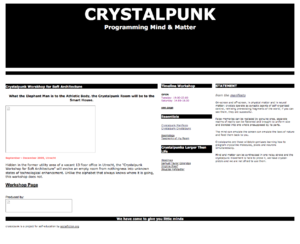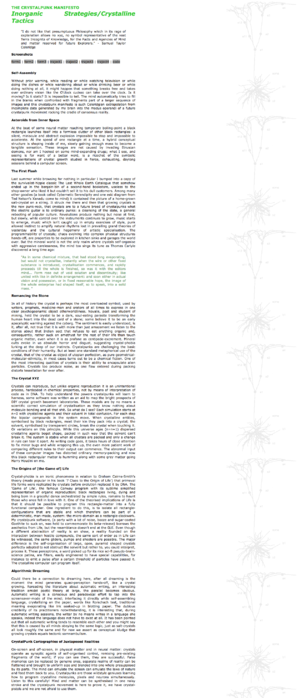2005 - The Crystalpunk Manifesto - Wilfried Hou Je Bek
Texto
THE CRYSTALPUNK MANIFESTO
Inorganic Strategies/Crystalline Tactics
"I do not like that presumptuous Philosophy which in its rage of explanation allows no xyz, no symbol representative of the vast Terra Incognita of Knowledge, for the Facts and Agencies of Mind and matter reserved for future Explorers." - Samuel Taylor Coleridge
Self-Assembly
Without prior warning, while reading or while watching television or while doing the dishes or while wandering about or while drinking beer or while doing nothing at all, it might happen that something breaks free and takes over ordinary vision like the O'clock cuckoo can take over the clock. Is it moving? Is it static? It is impossible to tell. The mind automatically tries to fill in the blanks when confronted with fragments part of a larger sequence of images and this crystalpunk manifesto is such Coleridgian extrapolation from incomplete data generated by my brain into the modus operandi of a future crystalpunk movement rocking the cradle of consensus reality.
Asteroids from Inner Space
At the beat of some neural matter reaching temporary boiling-point a black rectangle launches itself into a formless clutter of other black rectangles: a silent, miniscule and abstract explosion impossible to stop and impossible to accelerate. At the speed of one rectangle at a time, a hybrid conceptual structure is shaping inside of me, slowly gaining enough mass to become a tangible sensation. These images are not caused by invading Etruscan demons, nor am I hooked on some mind-expanding drugs; what I see, and seeing is for want of a better word, is a ricochet of the symbolic representations of crystal growth studied in fierce, exhausting, daylong sessions behind a computer screen.
The First Flash
Last summer while browsing for nothing in particular I bumped into a copy of the survivalist-hippie classic The Last Whole Earth Catalogue that somehow ended up in the bargain-bin of a second-hand bookstore, useless to the shop-owner who liked it but couldn't sell it to his dull customers. Among many other goodies (a book called Cybernetic Serendipity and one eski diagram from Ted Nelson's Xanadu come to mind) it contained the picture of a home-grown salt-crystal on a string. It struck me there and then that growing crystals is the new punk-rock, that crystals are to a future breed of crystalpunks what the electric guitar is to ordinary punks: a cleansing of the slate, a general rebooting of popular culture. Revolutions produce nothing but noise at first, but slowly, while control over the instruments continues to grow, music starts to emerge, music which isn't caught up in empty exercises of style, punk allowed instinct to amplify natural rhythms lost in prevailing grand theories of yesterday and the cultural hegemony of artistic specialisation. The programmability of crystals; chaos evolving into complex physical structures hands-off, are properties to be explored in kitchen sinks and garages the world over. But the mineral world is not the only realm where crystals self-organise with aggressive carelessness, the mind too sings its tune as Thomas Carlyle discovered a long time ago:
"As in some chemical mixture, that had stood long evaporating, but would not crystallise, instantly when the wire or other fixed substance is introduced, crystallisation commences, and rapidly proceeds till the whole is finished, so was it with the editors mind... Form rose out of void solution and discontinuity; like united with like in definite arrangement: and soon either in actual vision and possession, or in fixed reasonable hope, the image of the whole enterprise had shaped itself, so to speak, into a solid mass."
Romancing the Stone
In all of history the crystal is perhaps the most overloaded symbol; used by writers, prophets, medicine-man and orators of all times to express in one clear psychogeonamic object otherworldliness. Novalis, poet and student of mining, held the crystal to be a dark, soul-eating parasite transforming the human heart into the dead cold of a stone; some believe it to be an early apocalyptic warning against the cyborg. The sentiment is easily understood; is it, after all, not true that it is with more than just amazement we listen to the stories about that Indian sect that refuses to eat anything organic and, consequently, rather suck on amethyst for the rest of their life than touch organic matter, even when it is as profane as centipede-excrement. Mineral cults evoke in us absolute horror and disgust, suggesting crystal-phobia lurking at the deep of our instincts. Crystalpunks are challenging the basic conditions of their humanity. But at least one standard metaphorical use of the crystal, that of the crystal as object of utopian perfection, as pure geometricalmolecular- ethnicity, in most cases turns out to be a chemical fiction. One of the most interesting qualities of crystals is their ability to encapsulate alien particles. Crystals too produce noise, as one flaw entered during packing distorts tessellation for ever after.
The Crystal XYZ
Crystals can reproduce, but unlike organic reproduction it is an unintentional process, hardcoded in chemical properties, not by means of interpretation of code as in DNA. To help understand the powers crystalpunks will learn to harness, some software was written as an aid to map the bright prospects of DIY crystal growth basement laboratories. These models are by no means a scientific correct simulation of crystallisation as they know nothing about molecule-bonding and all that shit. So what do I see? Each simulation starts at n=0 with crystalline agents and their solvent in total confusion. For each step the bipolar compounds in the system move. When crystalline entities, symbolised by black rectangles, meet their kin they pack into a crystal; the solvent, symbolised by transparent circles, break the crystal when touching it. Or variations on this principle. While this universe ages (n=n+1) dispersed crystalline agents beget shape, packed in such way that the solvent can't break it. The system is stable when all crystals are packed and only a change in rule can tear it apart. As writing code goes, it takes hours of close attention to fix minor bugs and while wrapping this up, the even more patient work of comparing different rules to their output can commence. The abnormal input of these computer images has distorted ordinary memory-packing and now this black rectangular matter is humming along with some grey matter going Harry Houdini on me.
The Origins of [the Game of] Life
Crystal-phobia is an ironic phenomena in relation to Graham Cairns-Smith's theory (made popular in his book '7 Clues to the Origin of Life') that primeval life forms were replicated by crystals before evolution replaced it by DNA. The 'Game of Life', the famous Conway program with its sublime simplified representation of organic reproduction: black rectangles living, dying and being born in a graceful dance orchestrated by simple rules, remains to haunt those who once fell in love with it. One of the theorised implications of Life is that it should be possible to program this rectangle-matter into a fully functional computer. One ingredient to do this, is to isolate all rectangleconfigurations that are stable and which therefore can be part of a deterministic, man-made, system: the micro-domain as a rectangle-clockwork. My crystalpunk software, (a party with a lot of noise, booze and sugar-coated Goethite to suck on, was held to commemorate its beta-release) borrows the aesthetics from Life, but the resemblance doesn't end at the GUI. Even though a different abstraction of reality is on show, a reality founded on the interaction between hostile compounds, the same sort of order as in Life can be witnessed, the same gliders, pumps and shooters are possible. The major difference is the self-organisation of large, open, pyramid shaped crystals perfectly adapted to not obstruct the solvent but rather to, you could interpret, process it. These perceptrons, a word picked up for its nice sci-fi pseudo-brainscience patina, are filters, easily engineered to have special capabilities, for instance to emit a pulse after a certain threshold of particles have passed it. The crystalline computer can program itself.
Algorithmic Dreaming
Could there be a connection to dreaming here, after all dreaming is the moment the mind generates quasi-perception hands-off, like a crystal growing. Rereading the literature about automatic writing, an interesting tradition amidst poetic theory at large, the parallel becomes obvious. Automatic writing is a conscious and paradoxical effort to tap into the screensaver-mode of the mind; interfacing it directly while self-assembling language, crystallizing on the paper, words like Rorschach test, traditional meaning evaporating like ink soaked-up in blotting paper. The dubious credibility of its practitioners notwithstanding, it is interesting that, during automatic writing sessions, the writer by no means writes in a language she speaks, indeed the language does not have to exist at all. It has been pointed out that all automatic writing tends to resemble each other and you might say that this is caused by all minds obeying to the same logic, just as salt-crystals all look roughly the same and for now we assert as conceptual kludge that growing crystals equals tectonic somnambulism.
CrystalPunk Cartographies of Juxtaposed Realities
On-screen and off-screen, in physical matter and in neural matter: crystals operate as synaptic agents of self-organised control, remixing pre-existing fragments of the world; if you can see them, they are successful. False memories can be replaced by genuine ones, separate realms of reality can be flattened and brought to uniform size and blended into one whole presupposed by its parts. The mind can emulate the screen can emulate the laws of nature and feed them back to you. Crystalpunks are those wildstyle geniuses learning how to program crystalline molecules, pixels and neurons simultaneously. Listen to this carefully! Mind and matter can be synthesised in one noisy stroke and the crystalpunk movement is here to prove it, we have crystalpistols and we are not afraid to use them.
Contexto
Autoras
Archivo
Archivo:THE CRYSTAL-PUNK MANIFESTO Inorganic Strategies-Crystalline Tactics.pdf
Fuentes
Enlaces
Primera edición:
URL: http://spacecollective.org/wilfriedhoujebek/2867/THE-CRYSTALPUNK-MANIFESTO
Wayback Machine: http://web.archive.org/web/20160327210935/http://spacecollective.org/wilfriedhoujebek/2867/THE-CRYSTALPUNK-MANIFESTO, https://web.archive.org/web/20051221120149/http://socialfiction.org:80/crystalpunk.html https://web.archive.org/web/20060204134424/http://socialfiction.org:80/crystalpunk/index.html


